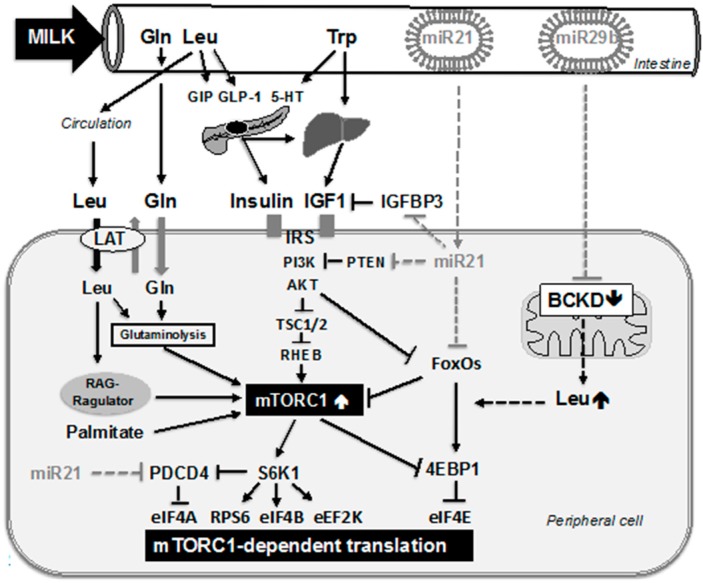Figure 2.
Working model of milk-induced mTORC1-dependent translation. Milk’s hardware is represented by fast-hydrolyzed amino acids leucine (Leu), glutamine (Gln) and tryptophan (Trp). Gln promotes cellular Leu uptake via the bidirectional amino acid transporter (LAT). Leu activates mTORC1 by interacting with the RAG-Ragulator complex and activates glutamate dehydrogenase, the key enzyme of glutaminolysis that activates mTORC1. Leu stimulates incretin production of glucose-dependent insulinotropic polypeptide (GIP) and glucagon-like peptide 1 (GLP-1), both stimulating insulin production. Trp via conversion to 5-hydroxytryptophan (5-HT) stimulates glucose-induced insulin secretion. Trp and insulin are required for the hepatic production of insulin-like growth factor-1 (IGF1). Insulin and IGF1 activate insulin receptor substrate (IRS), phosphoinositol-3 kinase (PI3K) and the kinase AKT, which via phosphorylation of tuberous sclerosis complex 2 (TSC2) suppresses TSC2’s inhibitory activity towards RAS-homolog enriched in brain (RHEB), the final activator of mTORC1. Milk-derived Leu, Gln and Trp and milk-derived palmitate all synergize in activating mTORC1 leading to phosphorylation of S6K1 and 4EBP1. S6K1-mediated phosphorylation of PDCD4 attenuates its inhibitory function towards eIF4A. Phosphorylation of 4EBP1 attenuates its inhibition of eIF4E. Further steps promoting translation include the S6K1-mediated phosphorylation of the translation factors RPS6, eIF4B, and eEF2K. Milk’s software program up-tuning mTORC1-dependent translation is apparently represented by milk’s exosomal microRNA-29b (miR29b) and microRNA-21 (miR21). MiR29b targets the core unit of branched-chain ketoacid dehydrogenase (BCKD), the mitochondrial key enzyme attenuating oxidative BCAA catabolism. This increases the availability of Leu for mTORC1 activation as well as synthesis of functionally important BCAA-enriched proteins. MiR21 targets IGF binding protein 3 (IGFBP3), thus increasing IGF1 bioactivity, targets phosphatase and tensin homolog (PTEN), thus activates AKT and subsequently mTORC1 and suppresses FoxO transcription factors, which are negative regulators of mTORC1. MiR21 may also affect FoxO-dependent expression of 4EBP1. MiR21 targets and inhibits the mRNA of PDCD4. PDCD4 protein is further degraded by S6K1-mediated phosphorylation. Thus, milk’s hardware and software program apparently function in a synergistic and potentiating fashion to activate mTORC1-dependent translation.

